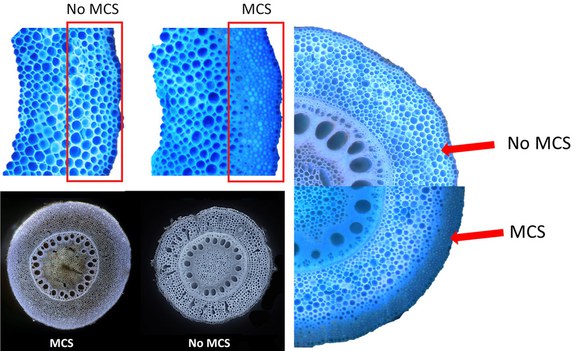Novel use of laser technology paves way for future precision breeding
Problem
Can we breed more productive crops that are resilient to climate variability?
Extreme precipitation events, prolonged droughts, temperature extremes, and elevated pressures from pests and diseases prompt the need for the breeding of more resilient and productive crops.
Findings
A team of plant scientists has developed a novel use of its laser ablation tomography (LAT) system, a technology invented at Penn State, to visualize the anatomy of roots and see how soil organisms, such as fungi, nematodes, and insects, interact with the roots of different crop species.
- A pulsing ultraviolet laser excites various tissues affected by soil organisms. The light spectra given off by different cells allow the scientists to capture detailed images of microscopic slices that can be reconstructed in three dimensions.
Impact
This novel technology provides scientists with a unique perspective of the interactions in order to develop crops that more effectively grow under limited water and nutrient availability.
- Using LAT, a researcher can process many root samples in a short period of time, addressing a major limitation for researchers conducting genetic studies and running breeding programs.
- The technique allows researchers to conduct large, quantitative screenings to characterize genetic control of root anatomy and interactions with soil organisms.
Related Research Areas: Environmental Resilience and Advanced Agricultural and Food Systems
Research Credit
Team
- Jonathan Lynch, Christopher Strock, Kathleen Brown, Hannah Schneider, Tania Galindo-Castañeda, Xiangrong Guo, Bart Van Gansbeke, Diane Mather, Mitchell Roth, Martin Chilvers
Participating Departments
Partners
- University of Adelaide, Australia; Michigan State University
Competitive Funding
- Fulbright Teachers for Global Classrooms, USDA North Central Region Sustainable Agriculture
- Research and Education (SARE), U.S. Agency for International Development (USAID), U.S. Department of Energy
Federal and State Appropriations
- USDA NIFA Hatch Project PEN04582, Accession #1005492
Emerging Discoveries
Novel use of laser technology reveals interactions between roots, soil organisms
Published Research
Laser ablation tomography for visualization of root colonization by edaphic organisms
-
Strock, C. F., Schneider, H. M., Galindo-Castañeda, T., Hall, B. T., Van Gansbeke, B., Mather, D. E., Roth, M. G., Chilvers, M. I., Guo, X., Brown, K., & Lynch, J. P. (2019). Laser ablation tomography for visualization of root colonization by edaphic organisms. Journal of experimental botany, 70(19), 5327-5342. https://doi.org/10.1093/jxb/erz271
Office for Research and Graduate Education
Address
217 Agricultural Administration BuildingUniversity Park, PA 16802-2600
- Email agresearch@psu.edu
- Office 814-865-3136
Office for Research and Graduate Education
Address
217 Agricultural Administration BuildingUniversity Park, PA 16802-2600
- Email agresearch@psu.edu
- Office 814-865-3136







